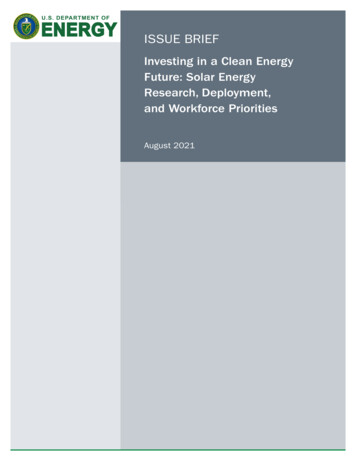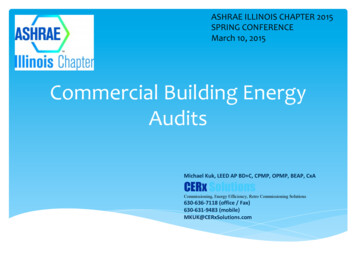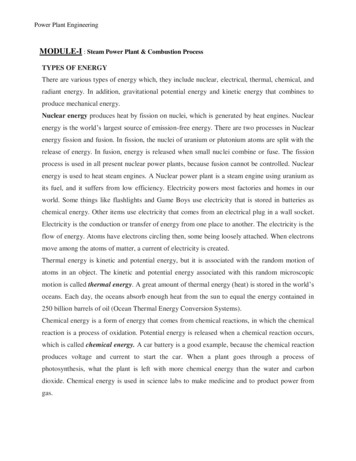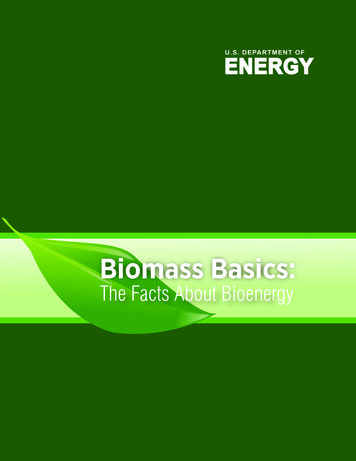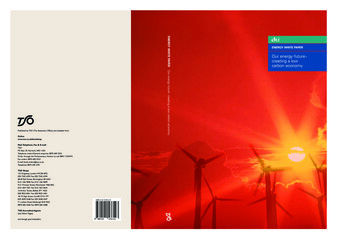
Transcription
EWP-Cover2/21/034:06 PMPage 1ENERGY WHITE PAPERENERGY WHITE PAPEROur energy future creating a lowcarbon economyOur energy future - creating a low carbon economy
EWP-Cover2/21/034:06 PMPage 2The DTI drives our ambition of‘prosperity for all’ by working tocreate the best environment forbusiness success in the UK.We help people and companiesbecome more productive bypromoting enterprise, innovationand creativity. We champion UKbusiness at home and abroad.We invest heavily in world-classscience and technology. We protectthe rights of working people andconsumers. And we stand up for fairand open markets in the UK, Europeand the world.
EnergyWhitePaper2/21/034:00 PMPage iOur energy future creating a lowcarbon economyPresented to Parliament by theSecretary of State for Trade and Industry byCommand of Her MajestyFebruary 2003Cm 5761 18.60
EnergyWhitePaper2/21/034:00 PMPage ii Crown Copyright 2003The text in this document (excluding the Royal Arms and departmental logos) may bereproduced free of charge in any format or medium providing that it is reproducedaccurately and not used in a misleading context. The material must be acknowledgedas Crown copyright and the title of the document specified.Any enquiries relating to the copyright in this document should be addressed toThe Licensing Division, HMSO, St Clements House, 2-16 Colegate, Norwich, NR3 1BQ.Fax: 01603 723000 or e-mail: licensing@cabinet-office.x.gsi.gov.uk
EnergyWhitePaper2/21/034:00 PMPage 1ContentsForeword .3Section OneOverview .5Chapter 1 Cleaner, smarter energy .6Section TwoThe low carbon economy .21Chapter 2 The Environment .22Chapter 3 Energy Efficiency .32Chapter 4 Low carbon generation .44Chapter 5 Clean Low Carbon Transport .63Section ThreeReliable, competitive and affordable supplies .75Chapter 6 Energy reliability .76Chapter 7 Productivity, competitiveness and innovation.95Chapter 8 Energy and the vulnerable .107Section FourDelivery through partnership .111Chapter 9.112Annexes.121Annex A Glossary.122Annex B References .134ENERGY WHITE PAPER Our energy future - creating a low carbon economy1
EnergyWhitePaper22/21/034:00 PMPage 2ENERGY WHITE PAPER Our energy future - creating a low carbon economy
EnergyWhitePaper2/21/034:00 PMPage 3ForewordEnergy is vital to a modern economy. We need energy to heat and lightour homes, to help us travel and to power our businesses. Our economyhas also benefited hugely from our country’s resources of fossil fuels coal, oil and gas.However, our energy system faces new challenges. Energy can nolonger be thought of as a short-term domestic issue. Climate change largely caused by burning fossil fuels - threatens major consequencesin the UK and worldwide, most seriously for the poorest countries whoare least able to cope. Our energy supplies will increasingly dependon imported gas and oil from Europe and beyond. At the same time,we need competitive markets to keep down costs and keep energyaffordable for our businesses, industries, and households.This white paper addresses those challenges. It gives a new directionfor energy policy. We need urgent global action to tackle climate change.We are showing leadership by putting the UK on a path to a 60%reduction in its carbon dioxide emissions by 2050. And, because thiscountry cannot solve this problem alone, we will work internationally tosecure the major cuts in emissions that will be needed worldwide.Our analysis suggests that, by working with others, the costs of actionwill be acceptable - and the costs of inaction are potentially muchgreater. And as we move to a new, low carbon economy, there are majoropportunities for our businesses to become world leaders in thetechnologies we will need for the future - such as fuel cells, offshorewind and tidal power. Science and technology are vital, and we will besupporting further research and development in these areas.In parallel, we need access to a wide range of energy sources andtechnologies and a robust infrastructure to bring the energy to where wewant to use it. We will maintain competitive markets in the UK and pressfor further liberalisation in Europe. And we renew our commitment thatno household in Britain should be living in fuel poverty by 2016-18.This white paper is a milestone in energy policy. It is based on the four pillarsof the environment, energy reliability, affordable energy for the poorest,and competitive markets for our businesses, industries and households.This white paper sets out a strategy for the long term, to give industrythe confidence to invest to help us deliver our goals - a truly sustainableenergy policy.ENERGY WHITE PAPER Our energy future - creating a low carbon economy3
EnergyWhitePaper42/21/034:00 PMPage 4ENERGY WHITE PAPER Our energy future - creating a low carbon economy
EnergyWhitePaper2/21/034:00 PMPage 5SectionOneOverviewENERGY WHITE PAPER Our energy future - creating a low carbon economy5
EnergyWhitePaper2/21/034:00 PMPage 6Chapter 1 Cleaner, smarter energy1.1 Our country needs a new energy policy.Despite the improvements we have made overthe last five years, today’s policy will not meettomorrow’s challenges. We need to addressthe threat of climate change. We must dealwith the implications of reduced UK oil, gasand coal production, which will make us a netenergy importer instead of an energyexporter. And over the next twenty years orso we will need to replace or update much ofour energy infrastructure.1.2 With these challenges, however, come newopportunities. The opportunity to shift the UKdecisively towards becoming a low carboneconomy where higher resource productivity- producing more with fewer naturalresources and less pollution - will contributeto higher living standards and a better qualityof life. The opportunity to develop, apply andexport leading-edge technologies, creatingnew businesses and jobs. And theopportunity to lead the way, in Europe andinternationally, in developing environmentallysustainable, reliable and competitive energymarkets that will support economic growth inevery part of the world.1.3 From heating and lighting to transport,industry and communications, energy isfundamental to almost everything we do.We expect it to be available whenever wewant it, to be affordable, safe andenvironmentally sustainable. It is only whensomething goes wrong - for instance, whenfamilies are left without heating and lightafter severe storms or when the lights go outin California - that we realise how muchmodern industrialised countries depend uponextremely complicated energy systems.1.4 Until the 1990s the energy system in the UK- as in most other countries - was largelyowned and controlled by Government. Todaythe UK has one of the most open energymarkets in the world. Open and competitivemarkets will remain vital to delivering theenergy we need. But it is Government’sresponsibility to set the overall goals for UKenergy policy and to ensure that our energymarkets and other policies deliver thosegoals. Energy producers, investors, businessand consumers need a clear, settled, longterm framework within which they can planand make decisions with confidence.1.5 The new energy policy that we set out inthis white paper is designed to provide this.It reflects, and will reinforce, our widercommitment to sustainable development1which challenges us to find ways to achieveeconomic, social and environmentalobjectives at the same time.The challenges we face.1.6 The first challenge we face is environmental.Climate change is real. Levels of carbondioxide (CO2) in the atmosphere, one of themain causes of climate change, have risenby more than a third since the industrialrevolution and are now rising faster than everbefore. This has led to rising temperatures:over the 20th century, the earth warmedup by about 0.6 C largely due to increasedgreenhouse gas emissions from humanactivities. The 1990s were the warmestdecade since records began.16ENERGY WHITE PAPER Our energy future - creating a low carbon economyOur sustainable development policy is set out in A better quality of life:a strategy for sustainable development for the UK, May 1999.
EnergyWhitePaper2/21/034:01 PMPage 7Section OneOverviewChapter 1: Cleaner, smarter energyChart 1.1Variations of the Earth’s SurfaceTemperature: Years 1000 to 21001.7 The rise in temperatures has beenaccompanied by changes in the worldaround us:Variations in the earth’s surface temperaturefrom year 1000 to 2000. Line shows 50-year2average. “SRES envelope” refers to therange of emission scenarios used as a basisfor the climate change projections in theIPCC Working Group I contribution to theThird Assessment Report.Chart 1.2Carbon Dioxide Levels overthe last 60,000 YearsSource: University of Berne and National Oceanicand Atmosphere Administration.Source: IPCC 2001. Climate change 2001: Synthesis Report. A contributionof Working Groups I, II and III to the Third Assessment Report of theIntergovernmental Panel on Climate Change (IPCC).ice caps are retreating from manymountain peaks like Kilimanjaro; global mean sea level rose by an averageof 1-2mm a year during the 20th century; summer and autumn arctic sea ice hasthinned by 40% in recent decades; global snow cover has decreased by 10%since the 1960s; El Nino events3 have become more frequentand intense during the last 20-30 years; usage of the Thames Barrier has increasedfrom once every two years in the 1980sto an average six times a year over the past5 years; and weather-related economic losses tocommunities and businesses haveincreased ten-fold over the last 40 years.1.8 In this century, without action to reduceemissions, the earth’s temperature is likely torise at a faster rate than any time in the last10,000 years or more. In the UK, the risks ofdroughts and flooding are likely to increase.Sea levels will rise, so that extreme highwater levels could be 10 to 20 times morefrequent at some parts of the east coast bythe end of the century. Worldwide, theconsequences could be devastating,especially in the developing world wheremany millions more people are likely to beexposed to the risk of disease, hunger andflooding. In addition, there is a risk of largescale changes such as the shut-down of the32 El Nino events change the weather patterns experienced in the regionsaround the tropical Pacific. This can affect rainfall patterns, and peopleliving in the region can find themselves having to deal with unusually wetor dry conditions.ENERGY WHITE PAPER Our energy future - creating a low carbon economy7
EnergyWhitePaper2/21/034:01 PMPage 8Gulf Stream or melting of the West Antarcticice sheet, which although they may have avery low probability of occurring, would havedramatic consequences.1.9 We cannot escape some climate change.But the worst effects can be avoided ifgreenhouse gases in the atmosphere arestabilised instead of being allowed to go onincreasing. The UNFCCC3 and its KyotoProtocol demonstrate that it is possible toreach global agreement on action, but farmore needs to be done. The UK will continueto show leadership but it cannot solve thisproblem alone. UK emissions of carbondioxide currently account for only about 2%of the global total. Our own actions will haveno impact on climate change unless theyare part of a concerted international effort.A wider effort is also necessary, for examplein bringing forward technological changes,to keep down costs to the UK and to avoidcompromising our competitiveness.We will therefore continue to work withother countries to establish both aconsensus around the need for change andfirm commitments to take action to reducecarbon emissions world wide within theframework of the UNFCCC. A key objectiveof the UK’s foreign policy in future will beto secure international commitment to thisambition. We also need to continue todevelop our understanding of climatechange, so that we can forecast withgreater precision the effects which mustbe mitigated. We are investing in climatechange research and recognise that thisis a crucial underpinning of the knowledgebase which informs our energy policies.4United Nations Framework Convention on Climate Change.8ENERGY WHITE PAPER Our energy future - creating a low carbon economy1.10 Our ambition is for the world’s developedeconomies to cut emissions of greenhousegases by 60% by around 2050. We thereforeaccept the Royal Commission onEnvironmental Pollution’s (RCEP’s)recommendation that the UK should putitself on a path towards a reduction incarbon dioxide emissions of some 60%5from current levels by about 2050 .Until now the UK’s energy policy has not paidenough attention to environmental problems.Our new energy policy will ensure thatenergy, the environment and economicgrowth are properly and sustainablyintegrated. In this white paper, we set outthe first steps to achieving this goal.1.11 We can get to a 60% cut in emissions by 2050in a number of ways. But leaving action untilthe last minute is not a serious option. If wedo not begin now, more dramatic, moredisruptive and more expensive change will beneeded later on. We need early, well-plannedaction to provide a framework within whichbusinesses and the economy generally,including the jobs and skills base, can adjustto the need for change. This will for exampleallow business to plan to act in the course ofnormal capital replacement cycles. It will alsoencourage new technologies to come forwardto help to meet the challenges we face.1.12 We have analysed carefully the likely impactson the UK economy of cutting emissions by60% by 2050. A good deal of caution isneeded in looking at economic changes oversuch a long period and given the sensitivity5RCEP’s recommendation of putting the UK on a path to ‘reducing carbondioxide emissions by some 60% from current levels by about 2050’ wasbased on a more detailed calculation of 58% reductions from 1997 levels.This would lead to 2050 emissions of 64 million tonnes of carbon (MtC).The Kyoto Protocol, and the UK’s current domestic targets, use 1990 as abaseline. A precise reduction of 60% in emissions from 1990 would resultin emissions of 65.8 MtC in 2050. As the RCEP recommendation implies,absolute precision five decades before 2050 is not possible. This whitepaper uses ‘around 65 million tonnes’ to describe the level of carbonemissions which a 60% cut would deliver by 2050.
EnergyWhitePaper2/21/034:01 PMPage 9Section OneOverviewChapter 1: Cleaner, smarter energyof the analysis to the assumptions made.But an extensive review by theIntergovernmental Panel on Climate Changesuggests that action aimed at stabilisingcarbon dioxide atmospheric concentrationsat no more than 550ppm would lead to anaverage GDP loss for developed countries6of around 1% in 2050 . This figure should,however, be more than offset by the reductionin the risks, eg of flooding, associated withclimate change. The outcome of our UKanalysis is consistent with that review,assuming that the world’s leading industrialnations act together. It suggests that the costimpact of effectively tackling climate changewould be very small - equivalent in 2050 tojust a small fraction (0.5-2%) of the nation’swealth, as measured by GDP, which by thenwill have tripled as compared to now.Chart 1.3Primary Energy Demand in 2002, UKNuclear9%6Report of Working Group III of Intergovernmental Panel on Climate Change,Mitigation, 2001.Coal15%Gas39%Oil35%Source: DTI provisional 2002 data based onDigest of UK Energy Statistics, table 1.1necessarily make it harder to achieve energy7reliability . Of the world’s leading industrialnations only two - Canada and the UK - arenet energy exporters. The others have allachieved economic growth as energyimporters. We will be able to do the same just as we did before North Sea oil and gas.The best way of maintaining energy reliabilitywill be through energy diversity. We needmany sources of energy, many suppliers andmany supply routes. Renewables andsmaller-scale, distributed energy sources - egmicro-CHP8 and fuel cells - will help us avoidover-dependence on imports and can makeus less vulnerable to security threats.1.13 The second challenge is the decline of theUK’s indigenous energy supplies - oil, gas,nuclear and coal. Our current demand forprimary energy (ie before transformation, eginto electricity) is shown below. Already weimport nearly half the coal we use. Much ofthe UK’s economically viable deep mined coalis likely to be exhausted within ten years.By around 2006 we will also be a netimporter of gas and by around 2010 of oil.By 2020 we could be dependent on importedenergy for three quarters of our total primaryenergy needs.1.14 As we shift from being a net energy exporterto being once again a net energy importer wemay become potentially more vulnerable toprice fluctuations and interruptions to supplycaused by regulatory failures, politicalinstability or conflict in other parts of theworld. But being an energy importer does notOther2%1.15 Norway will be a major source of our gasimports over the next decade. But we willalso need to look for supplies from elsewhereeg from Russia, the Middle East, North Africaand Latin America. This trade in energy willinvolve relationships of mutual dependence -7The phrase energy reliability is used in this white paper to encompass allaspects of energy security of supply.8Combined Heat and Power plant.ENERGY WHITE PAPER Our energy future - creating a low carbon economy9
EnergyWhitePaper2/21/034:01 PMPage 10their energy being as important to us as theirincome from us is to them. Our growinginterdependence also means that securingreliable energy supplies will need to be anincreasingly important part of our Europeanand foreign policy. We will workinternationally to promote regional stability,economic reform, open and competitivemarkets and appropriate environmentalpolicies in the regions that supply most of theworld’s oil and gas - Russia, the Middle East,North Africa and Latin America. We havealready secured a commitment to energyliberalisation in the European Union forindustrial customers by 2004 and overall by2007. This is vital not only to improve ourown access to diverse sources of supply butalso to allow UK companies to compete inwider markets.1.16 Our third challenge is the need to updatemuch of the UK’s energy infrastructure overthe next two decades. During the 1990sthere was significant new investment ingenerating capacity, especially for gas-firedplant. This was a response to the highelectricity prices and market structure of thetime. Some generating capacity has sincebeen mothballed and interest in building newplant, other than renewables, has declined.But looking ahead, there are further changesin prospect. European measures to limitcarbon emissions and to improve air qualityare likely to force the modernisation orclosure of most older coal-fired plant. In theabsence of new build or life extensions,nuclear power’s share of electricity productionwill shrink from its current level: there wouldbe only one plant still operating by 2025.And renewables will become a moresignificant source of electricity as we seek totackle climate change. Our current generationmix is shown in chart 1.4 below.10ENERGY WHITE PAPER Our energy future - creating a low carbon economyChart 1.4Electricity Generation in 2002, UKRenewables3%Nuclear23%Gas38%Coal32%Oil andOther4%Source: DTI estimates for 2002 on gross supplied basis,based on Digest of UK Energy Statistics, table 5.6.1.17 Over the coming years, substantialinvestment will also be required in otherparts of our energy infrastructure. Theelectricity distribution networks - designed forone-way transmission from large, centralisedpower stations to consumers - will need toadapt to more renewables often in peripheralparts of the country or offshore and to smallscale, decentralised power generation inhomes and businesses, sometimes drawingfrom the grid, sometimes contributing to it.As we adapt to becoming a net gas importerwe will need additional connections tosupplies of both piped and liquefied naturalgas (LNG) from a range of sources. In thelonger-term, as we potentially move todifferent fuels for vehicles (eg compressednatural gas or hydrogen), major investmentswill be needed in the fuel deliveryinfrastructure.
EnergyWhitePaper2/21/034:01 PMPage 11Section OneOverviewChapter 1: Cleaner, smarter energyThe goals of ournew energy policy.1.18 As we address these three challenges, wewill have four goals for our energy policy: to put ourselves on a path to cut the UK’scarbon dioxide emissions - the maincontributor to global warming - by some60% by about 2050, as recommendedby the RCEP, with real progress by 2020; to maintain the reliability of energysupplies; to promote competitive markets in theUK and beyond, helping to raise the rateof sustainable economic growth and toimprove our productivity; and determining the relative ‘weights’ of differingobjectives. But our approach is guided by thefollowing considerations: significant damaging climate change is anenvironmental limit that should not bebreached. We need to keep the UK on apath to 60% cuts in carbon dioxideemissions by 2050; reliable energy supplies are fundamental tothe economy as a whole and to sustainabledevelopment. An adequate level of energysecurity must be satisfied at all times inboth the short and longer term; liberalised and competitive markets willcontinue to be a cornerstone of energypolicy. Where the market alone cannotcreate the right signals (for example onthe environment) we will take steps thatencourage business to innovate anddevelop new opportunities to deliver theoutcomes we are seeking; and our policies should take account of impactson all sectors of society. Specific measureswill be needed for particular groups of people(for example to support those for whomenergy bills form a disproportionate burden).to ensure that every home is adequatelyand affordably heated.1.19 We believe these four goals can be achievedtogether. As far as possible we will ensurethat the market framework and policyinstruments reinforce each other to achieveour goals. Energy efficiency is likely to bethe cheapest and safest way of addressingall four objectives. Renewable energy willalso play an important part in reducing carbonemissions, while also strengthening energysecurity and improving our industrialcompetitiveness as we develop cleanertechnologies, products and processes.1.20 There will inevitably from time to time betensions between different objectives.For example, extremely high energy priceswould undoubtedly promote energy efficiencyand thereby help to reduce carbon emissions.But they would also have a negative effecton people on low incomes and on business.There is no simple mechanism forThe fuel mix.1.21 We do not propose to set targets for theshare of total energy or electricity supply tobe met from different fuels. We do notbelieve Government is equipped to decidethe composition of the fuel mix. We preferto create a market framework, reinforced bylong-term policy measures, which will giveinvestors, business and consumers the rightincentives to find the balance that will mosteffectively meet our overall goals.ENERGY WHITE PAPER Our energy future - creating a low carbon economy11
EnergyWhitePaper2/21/034:01 PMPage 121.22 We recognise, however, that this approach isnot enough on its own. In particular, specificmeasures are needed to stimulate thegrowth in renewable energy that will allow itto achieve the economies of scale andmaturity that will significantly reduce itscosts. In January 2000 we announced ouraim for renewables to supply 10% of UKelectricity in 2010, subject to the costs beingacceptable to the consumer. We introducedthe Renewables Obligation (which requiressuppliers in England and Wales to obtain anincreasing proportion of electricity fromrenewables year on year) in April last year.We also exempted renewable generationfrom the Climate Change Levy. By 2010these measures will provide the renewablesindustry with support worth around 1 billiona year. This is designed to deliver therequired expansion in renewables by then.In this white paper we set the ambition ofdoubling renewables’ share of electricitygeneration in the decade after that. In orderto achieve this and to ensure that renewablesmake a growing contribution to the fuel mixin the longer term it will be essential tomaintain a healthy research base.1.23 In reducing carbon dioxide emissions, ourpriority is to strengthen the contribution ofenergy efficiency and renewable energysources. This white paper sets out thepolicies we believe are necessary to achievethat. They mean energy efficiency andrenewables will have to achieve far more inthe next 20 years than they have until now.We believe that such ambitious progress isachievable. But it is uncertain.1.24 Nuclear power is currently an importantsource of carbon-free electricity. However, itscurrent economics make it an unattractiveoption for new, carbon-free generatingcapacity and there are also important issues12ENERGY WHITE PAPER Our energy future - creating a low carbon economyof nuclear waste to be resolved. These issuesinclude our legacy waste and continued wastearising from other sources. This white paperdoes not contain specific proposals for buildingnew nuclear power stations. However we donot rule out the possibility that at some pointin the future new nuclear build might benecessary if we are to meet our carbontargets. Before any decision to proceed withthe building of new nuclear power stations,there will need to be the fullest publicconsultation and the publication of a furtherwhite paper setting out our proposals.1.25 Coal fired generation will also have animportant part to play in widening thediversity of the energy mix provided wayscan be found materially to reduce its carbonemissions. We will continue to supportrelevant research projects, includinginternationally, to develop options for cleanercoal technologies and for carbon capture andstorage. Domestic coal production is likely tocontinue to decline as existing pits reach theends of their geological and economic lives.1.26 However, where there is the potential for coalcompanies to make worthwhile investments,they have to date been prevented by EUrules from seeking government help in doingso. In 2002 we negotiated the flexibility werequire at an EU level to correct this anomaly.We now propose to introduce an investmentaid scheme to help existing pits develop newreserves, where they are economically viableand help safeguard jobs.How we willachieve our goals.1.27 To achieve our goal of reducing carbonemissions we need to continue to decoupleeconomic growth from energy use andpollution. Since 1970, overall energy
EnergyWhitePaper2/21/034:01 PMPage 13Section OneOverviewChapter 1: Cleaner, smarter energyconsumption in the UK has increased byaround 15%, while the size of the economyhas doubled. In future we need to continueand accelerate this trend.1.28 Discussions under the UNFCCC to tackleclimate change beyond 2008-12 will start soon.On the basis of existing policies, includingthe full effect of our current Climate ChangeProgramme, we would expect UK carbondioxide emissions of some 135 million tonnesof carbon (MtC) in 2020. To be consistent withdemonstrating leadership in the internationalprocess, we expect to aim for cuts in carbonof 15-25 MtC below that by 2020.Chart 1.5Final Energy Consumption in 2002, UKBY SECTOROther13%Industry21%Domestic30%Transport36%BY END USE1.29 We believe it is possible to achieve this goalby reducing the amount of energy weconsume, together with a substantialincrease in renewable energy. Our currentenergy use is illustrated in chart 1.5 below.By making our intentions clear we aim toprovide the signals needed for firms to invest- and to help British manufacturers to beahead of the game in developing the greentechnologies that we expect to play a largepart in the world’s future prosperity. In thiswhite paper, we set out measures toimplement the objectives for 2010 set out inthe existing Climate Change Programme, andto provide a foundation for the further carboncuts we will need by 2020.1.30
accompanied by changes in the world around us: ice caps are retreating from many mountain peaks like Kilimanjaro; global mean sea level rose by an average of 1-2mm a year during the 20th century; summer and autumn arctic sea ice has thinned by 40% in recent decades; global snow cover has decreased by 10% since the 1960s;


